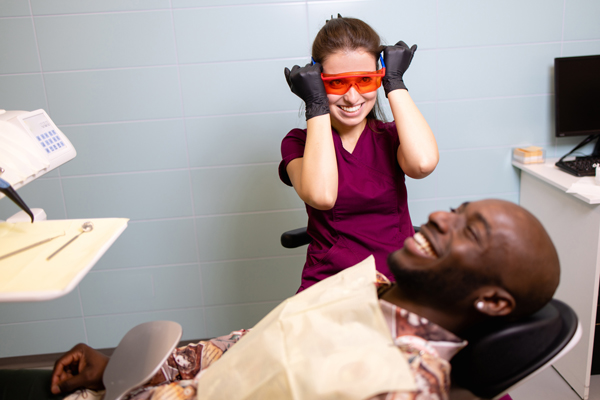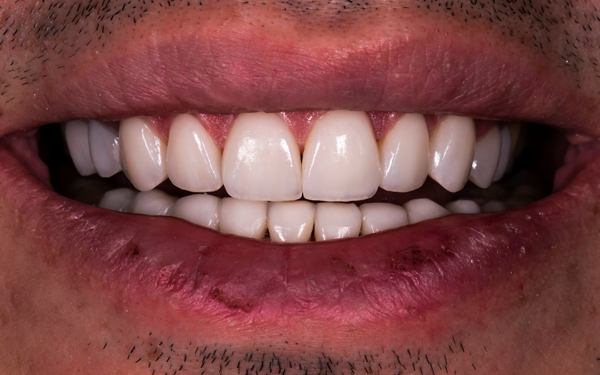
Therapeutic Orthotics Solutions
Orthotic Solutions for your dental problems
Therapeutic orthotics are made of clear acrylic, molded to fit your lower teeth. (We fit to the lower teeth whenever possible, because orthotics attached to lower teeth are more comfortable than those attached to upper teeth.) The biting surface of the orthotic simulates a set of properly positioned teeth. The orthotic bite relaxes your jaw muscles, aligning the jaw joints to bring balance to the jaw muscles and joints when they are closed, in a resting position. That balance extends to the musculo-skeletal systems of the shoulders, neck, head and back – to help provide alignment, stability and comfort to those systems as well.

How a therapeutic orthotic is designed and how much time it is worn, depends on individual circumstances. Flat-plane versus anatomic; wearing it part-time or most-of-the-time, versus wearing it full-time including while eating. These are all options to be considered.
Start with a proper diagnosis
A diagnosis is essential to providing proper treatment, whether it is a non-pain patient wanting to save teeth from being destroyed by a stressful bite, or a pain patient who’s goal is relief in addition to saving their deteriorating teeth. It is necessary to differentiate among muscle disorders, TMJ disk disorders, chronic hypo mobilities, inflammatory disorders, traumatic injuries, growth disorders and abnormal jaw closure patterns as part of each case. Through this diagnosis we can provide the best treatment options for each patient. We bundle the cost of the diagnostic procedures into the cost of the various orthotic options.
Non-Pain Patient: Therapeutic Orthotic Treatment
These provide protection from excessive wear and tear on teeth, dental restorations and periodontal tissues caused by clenching, grinding and/or gnashing of teeth. This orthotic is for part time use only and are made to a rested jaw muscle position that minimizes or eliminates clenching and grinding. We use a physio-therapeutic Ultra-Low Frequency TENS to relax tense jaw muscles and determine the relaxed bite position for the patient, which gives the best jaw support and protection from bite stresses while the orthotic is being worn.
Pain Patient: Initial Therapeutic Orthotic Treatment
The pain patient has special needs. To decrease the suffering caused by a pathological biting position, Ultra Low Frequency TENS is used to relax tense jaw muscles and determine the relaxed bite position that has the best potential to optimize head, neck and jaw posture, give the best support for jaw muscles and joints, reducing bite stresses on the teeth.
The initial therapeutic orthotic for a pain patient is designed to be worn full-time except while eating. It the most common starting orthotic we make. It has a high success rate, is easily maintained, and has a relatively low cost. Wearing this type of orthotic as prescribed usually drastically reduces or completely eliminates pain and other related symptoms within a few days to weeks of wearing it.
After the initial healing period, patients continue wearing their initial therapeutic orthotic as long as it still fits (it should as long as no major dental work is performed). Some patients try to ease off use of their orthotic as much as return of their symptoms allows. They may wear their orthotic only when they feel they need it the most. Other patients upgrade to a higher cost anatomic orthotic that they can use full time-including to eat with.
NOTE: Orthotics do not fix teeth. On its own, it does not permanently correct the pathological bite arrangement of the teeth that caused the initial disorder. Therapeutic Orthotics help bring balance to the jaw and neck muscles, but only during wear of the orthotic.
Think of it this way: if you have poor eyesight and you need glasses to correct your eyesight, you wear your glasses for them to work. Your glasses will not heal your eyes. If you have flat feet and you need foot orthotics for a proper stance, the foot orthotics will only work while in your shoes. Your foot orthotics will not heal your flat feet. To permanently fix the bite of your teeth so a Therapeutic Orthotic is no longer required for proper alignment, another phase of treatment is required.
Reconstructive Orthotic Treatment
For many, the thought of wearing a Therapeutic Orthotic for a lifetime is undesirable. Though comfortable to wear, Therapeutic Orthotics require maintenance and need replacement if they they wear out, become broken or lost, or don’t fit the teeth anymore (i.e. if major dental work has been performed). Many patients want a more permanent solution. That solution requires a greater deal of care when determining and perfecting the bite position.
Reconstructive Orthotics are the first stage toward long-term phase-two treatment solutions consisting of Orthodontic Braces, Reconstructive Porcelain Restorations (Smile Rejuvenation), or a combination of orthodontics and reconstructive porcelain restorations.
There are two types of reconstructive Orthotics: Bonded Tooth Colored and Removable Clear Acrylic. Both have anatomic biting surfaces for mimicking an ideal bite position. There are cusps that help provide a stable “Home” for upper and lower jaws to bite or occlude. This allows for more efficient chewing. This type of orthotic is monitored for several months and then adjusted as the jaw muscles relax, the jaw joints decompress, and posture improves.
Removable Clear Acrylic Reconstructive Orthotic Treatment
For patients who suffer from more complex TMJ disorder pain issues and wish to have phase-two treatment in the future. Similar to the Pain Patient Therapeutic Orthotics, we use Computerized Jaw Tracking, 8 channel EMGs, jaw joint Sonography, and extremely low radiation CT-Scan imaging to determine the appropriate bite position for the jaw.
Reconstructive orthotics need to be worn full-time including during eating, for usually at least three months and sometimes six to 18 months or more. How long this will take depends on the amount of bite rebalancing orthotic adjustments and to what extent.

Three bite rebalancing adjustments are covered during the first three months in the cost of the Pain Patient Removable Reconstructive Orthotic.
Bonded Tooth-Colored Reconstructive Orthotic Treatment
These are really comfortable as they are bonded or glued on the tooth surfaces of the lower and/or upper teeth, making it easy to eat and talk with these orthotics. Special home care devices are provided to help keep the teeth and gum tissue healthy while wearing our Bonded Reconstructive Orthotic. Professional cleanings are required by our hygienist every three months so gum tissue remains healthy while wearing Bonded Tooth-Colored Reconstructive Orthotics.
These orthotics are practically invisible in your mouth and they blend into your teeth. They can be in the mouth for up to 2 years as long as proper care is maintained. With previously worn down, crooked or misshapen teeth, the upper orthotic actually looks better then the original teeth and is a preview of what a smile-makeover would look like.
The cost of three bite rebalancing adjustments during the first three months are covered in the entire cost of Bonded Tooth-Colored Reconstructive Orthotics.
Phase II Treatments
Smile Rejuvenation
Smile Rejuvenation is the rebuilding of broken, dentally compromised teeth that cannot be corrected with Orthodontic care. We use attractive and modern porcelain materials to not only give a natural, attractive looking set of teeth but to correct the bite problems that led to the initial TMJ Disorder.
Smile Rejuvenation can be done at the same time as Orthodontic care or on its own. Smile Rejuvenation is tailored to the patient’s individual needs and time frame. Treatment may be staged in order to defer costs over a greater period of time.
Orthodontic Care – Braces
Many TMJ Disorder patients choose Orthodontic Care or Braces as their phase-two treatment.
It is a conservative, less expensive option (compared to the cost of bite reconstruction with porcelain veneers or crowns), and often most effective option, to maintain jaw joints and muscle comfort and the general posture that was achieved during phase-one orthotic therapy.


